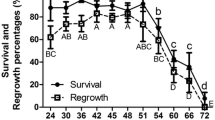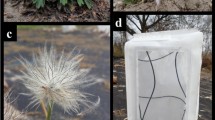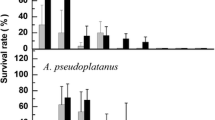Abstract
Endoreplication is a process by which cells replicate their genomes without mitosis, resulting in an increase in nuclear DNA ploidy. This study is the first to report that oxidative stimuli from cryopreservation of seeds in liquid nitrogen induces endoreplication. We list evidence that the cryopreservation of red pitaya seeds (Hylocereus costaricensis) in liquid nitrogen for 30 and 60 days induced genome duplication stimuli via endoreplication. It was demonstrated that this conservation technique modulates the levels of hydrogen peroxide (H2O2) and antioxidant enzymes, triggering oxidative stimuli. The flow cytometry analysis of cladodes revealed different levels of ploidy between the tissues (mixoploidy) and that seedlings from the longest cryopreservation times of seeds showed higher percentages of octoploid nuclei when compared to the control treatment. The cryopreservation of seeds for 60 days also allowed increases of approximately 130% in seedling biomass, which is possibly related to the increases in ploidy levels resulting from endoreplication. It was also shown that cryopreservation of seeds with cryoprotectant solutions (PVS2) increases the efficiency of antioxidant metabolism in eliminating H2O2, repressing oxidative signalling and consequently endoreplication, maintaining ploidy levels and stable growth patterns.
Graphical abstract

Key Message
Oxidative signaling in seeds (induced by cryopreservation) triggers stimuli to promote endoreplication in pitaya seedlings, resulting increases in ploidy levels and in plant biomass.







Similar content being viewed by others
Data availability
Data will be made available on request.
References
Alves MA, Rosa SDVF, Ricaldone MA et al (2021) Physiological, biochemical, and ultrastructural aspects of Coffea arabica L. seeds under different cryopreservation protocols. Ciênc Agrotec 45:e027020. https://doi.org/10.1590/1413-7054202145027020
Barkla BJ, Rhodes T, Tran KNT et al (2018) Making epidermal bladder cells bigger: Developmental-and salinity-induced endopolyploidy in a model halophyte. Plant Physiol 177:615–632. https://doi.org/10.1104/pp.18.00033
Brasil (2009) Regras para Análise de Sementes (RAS). Ministry of Agriculture, Pecuária e Abastecimento, Brasília.
Breuer C, Braidwood L, Sugimoto K (2014) Endocycling in the path of plant development. Curr Opin Plant Biol 17:78–85. https://doi.org/10.1016/j.pbi.2013.11.007
Bueje JA, Aust SD (1978) Microsomal lipid peroxidation. Methods Enzymol. https://doi.org/10.1016/S0076-6879(78)52032-6
Chen P, Sjogren CA, Larsen PB, Schnittger A (2019) A multi-level response to DNA damage induced by aluminium. Plant J 98:479–491. https://doi.org/10.1111/tpj.14231
Chevalier C, Bourdon M, Pirrello J et al (2014) Endoreduplication and fruit growth in tomato: Evidence in favour of the karyoplasmic ratio theory. J Exp Bot 65:2731–2746. https://doi.org/10.1093/jxb/ert366
Corneillie S, De Storme N, Van Acker R et al (2019) Polyploidy affects plant growth and alters cell wall composition. Plant Physiol 179:74–87. https://doi.org/10.1104/pp.18.00967
Das MC, Devi SD, Kumaria S, Reed BM (2021) Looking for a way forward for the cryopreservation of orchid diversity. Cryobiology 102:1–14. https://doi.org/10.1016/j.cryobiol.2021.05.004
de Oliveira Prudente D, Paiva R, Domiciano D et al (2019) The cryoprotectant PVS2 plays a crucial role in germinating Passiflora ligularis embryos after cryopreservation by influencing the mobilization of lipids and the antioxidant metabolism. J Plant Physiol 239:71–82. https://doi.org/10.1016/j.jplph.2019.05.014
Del Prete S, Molitor A, Charif D et al (2019) Extensive nuclear reprogramming and endoreduplication in mature leaf during floral induction. BMC Plant Biol 19:1–19. https://doi.org/10.1186/s12870-019-1738-6
Doležel J, Bartoš J (2005) Plant DNA flow cytometry and estimation of nuclear genome size. Ann Bot 95:99–110. https://doi.org/10.1093/aob/mci005
Duan S, Hu L, Dong B et al (2020) Signaling from plastid genome stability modulates endoreplication and cell cycle during plant development. Cell Rep 32:108019. https://doi.org/10.1016/j.celrep.2020.108019
Ferreira D (2014) Sisvar: a Guide for its Bootstrap procedures in multiple comparisons. Ciênc Agrotec. 32:109–112. https://doi.org/10.1590/S1413-70542014000200001
Foyer CH, Wilson MH, Wright MH (2018) Redox regulation of cell proliferation: Bioinformatics and redox proteomics approaches to identify redox-sensitive cell cycle regulators. Free Radic Biol Med 122:137–149. https://doi.org/10.1016/j.freeradbiomed.2018.03.047
Galdiano Jr RF, Lemos EGM, Vendrame WA (2013) Cryopreservation, early seedling development, and genetic stability of Oncidium flexuosum Sims. Plant Cell Tiss Organ (PCTOC) 114:139–148. https://doi.org/10.1007/s11240-013-0304-4
Giannopolitis CN, Ries SK (1977) Superoxide dismutases. Plant Physiol 59:315–318. https://doi.org/10.1016/S0079-6603(08)60843-0
Havir EA, McHale NA (1987) Biochemical and developmental characterization of multiple forms of catalase in tobacco leaves. Plant Physiol 84:450–455. https://doi.org/10.1104/pp.84.2.450
Hendrix S, Keunen E, Mertens AIG et al (2018) Cell cycle regulation in different leaves of Arabidopsis thaliana plants grown under control and cadmium-exposed conditions. Environ Exp Bot 155:441–452. https://doi.org/10.1016/j.envexpbot.2018.06.026
Hendrix S, Iven V, Eekhout T et al (2020) Suppressor of gamma response 1 modulates the DNA damage response and oxidative stress response in leaves of cadmium-exposed Arabidopsis thaliana. Front Plant Sci. https://doi.org/10.3389/fpls.2020.00366
Hughes ZE, Malajczuk CJ, Mancera RL (2013) The effects of cryosolvents on DOPC-β-sitosterol bilayers determined from molecular dynamics simulations. J Phys Chem B 117:3362–3375. https://doi.org/10.1021/jp400975y
James Antony JJ, Zakaria S, Zakaria R et al (2019) Biochemical analyses of Dendrobium Sabin Blue PLBs during cryopreservation by vitrification. Physiol Mol Biol Plants 25:1457–1467. https://doi.org/10.1007/s12298-019-00703-2
Johansen DA (1940) Plant microtechnique. McGraw-Hill Publishing Company Ltd, London
Lang L, Schnittger A (2020) Endoreplication—a means to an end in cell growth and stress response. Curr Opin Plant Biol 54:85–92. https://doi.org/10.1016/j.pbi.2020.02.006
Li F, Wang L, Zhang Z et al (2019) ZmSMR4, a novel cyclin-dependent kinase inhibitor (CKI) gene in maize (Zea mays L.), functions as a key player in plant growth, development and tolerance to abiotic stress. Plant Sci 280:120–131. https://doi.org/10.1016/j.plantsci.2018.03.007
Liu Z, Chen G, Gao F et al (2019) Transcriptional repression of the APC/C activator genes ccs52a1/a2 by the mediator complex subunit MED16 controls endoreduplication and cell growth in Arabidopsis. Plant Cell 31:1899–1912. https://doi.org/10.1105/tpc.18.00811
Lobo NNM, Andrade GC, de Oliveira AP et al (2023) Anatomical adaptations in the stem of Discocactus catingicola (Cactaceae) to the highly threatened ironstone outcrops from southeastern Brazil. Flora Morphol Distrib Funct Ecol Plants 305:152346. https://doi.org/10.1016/j.flora.2023.152346
Mahapatra K, Roy S (2019) An insight into the folding and stability of Arabidopsis thaliana SOG1 transcription factor under salinity stress in vitro. Biochem Biophys Res Commun 515:531–537. https://doi.org/10.1016/j.bbrc.2019.05.183
Mahapatra K, Roy S (2020) An insight into the mechanism of DNA damage response in plants- role of suppressor of gamma response 1: an overview. Mutat Res Fundam Mol Mech Mutagen 819–820:111689. https://doi.org/10.1016/j.mrfmmm.2020.111689
Mahapatra K, Roy S (2021) SOG1 transcription factor promotes the onset of endoreduplication under salinity stress in Arabidopsis. Sci Rep 11:1–26. https://doi.org/10.1038/s41598-021-91293-1
Menezes TP, Gomes WA, Pio LAS et al (2012) Micropropagação e endorreduplicação em pitaya vermelha, hylocereus undatus haw. Biosci J 28:868–876
Menezes TP, Pio LAS, Ramos JD et al (2016) Endoreduplication in floral structure, vegetative and fruits of red pitaya with white pulp. Biosci J. https://doi.org/10.14393/bj-v32n4a2016-32977
Mercado-Silva EM (2018) Pitaya—Hylocereus undatus (Haw). In: Priya R (ed) Exotic fruits. Elsevier Inc., Amsterdam, pp 339–349
Mhamdi A, Van Breusegem F (2018) Reactive oxygen species in plant development. Dev 145:1–28. https://doi.org/10.1242/dev.164376
Morillo AC, Mora MS, Morillo Y (2022) Analysis of the genetic diversity of dragon fruit based on ISSR markers in Colombia. Brazilian J Biol 82:1–10. https://doi.org/10.1590/1519-6984.256451
Murashige T, Skoog F (1962) A revised medium for rapid growth and bio assays with tobacco tissue cultures. Physiol Plant 15:473–497. https://doi.org/10.1111/j.1399-3054.1962.tb08052.x
Murray KA, Gibson MI (2022) Chemical approaches to cryopreservation. Nat Rev Chem 6:579–593. https://doi.org/10.1038/s41570-022-00407-4
Nakano Y, Asada K (1981) Hydrogen peroxide is scavenged by ascorbate-specific peroxidase in spinach chloroplasts. Plant Cell Physiol 22:867–880. https://doi.org/10.1093/oxfordjournals.pcp.a076232
Nowicka A, Kovacik M, Tokarz B et al (2021) Dynamics of endoreduplication in developing barley seeds. J Exp Bot 72:268–282. https://doi.org/10.1093/jxb/eraa453
Paige KN (2018) Overcompensation, environmental stress, and the role of endoreduplication. Am J Bot 105:1105–1108. https://doi.org/10.1002/ajb2.1135
Pence VC, Ballesteros D, Walters C et al (2020) Cryobiotechnologies: tools for expanding long-term ex situ conservation to all plant species. Biol Conserv 250:108736. https://doi.org/10.1016/j.biocon.2020.108736
Pinto MS, Paiva R, Silva DPC et al (2016) Cryopreservation of coffee zygotic embryos: dehydration and osmotic rehydration. Ciênc Agrotec 40(4):380–389. https://doi.org/10.1590/1413-70542016404007616
Porto JMP, Paiva R, Campos NA et al (2014) Cryopreservation of seeds of barbatimão with different water contents. Aust J Basic Appl Sci 13:250–256. http://ajbasweb.com/old/ajbas/2014/August/250-256.pdf
Qi F, Zhang F (2020) Cell cycle regulation in the plant response to stress. Front Plant Sci 10:1–10. https://doi.org/10.3389/fpls.2019.01765
Raju R, Bryant SJ, Wilkinson BL, Bryant G (2021) The need for novel cryoprotectants and cryopreservation protocols: insights into the importance of biophysical investigation and cell permeability. Biochim Biophys Acta Gen Subj 1865:129749. https://doi.org/10.1016/j.bbagen.2020.129749
Ratajczak E, Małecka A, Ciereszko I, Staszak AM (2019) Mitochondria are important determinants of the aging of seeds. Int J Mol Sci. https://doi.org/10.3390/ijms20071568
Ren R, Li Z, Li B et al (2019) Changes of pollen viability of ornamental plants after long-term preservation in a cryopreservation pollen bank. Cryobiology 89:14–20. https://doi.org/10.1016/j.cryobiol.2019.07.001
Ren L, Wang MR, Wang QC (2021) ROS-induced oxidative stress in plant cryopreservation: occurrence and alleviation. Planta 254:1–18. https://doi.org/10.1007/s00425-021-03784-0
Rodrigues MGF, Ferreira AFA, da Malagutti E, S, et al (2021) Cladode size and collection time for pitahaya propagation. Ciênc Agrotec. https://doi.org/10.1590/1413-7054202145004821
Sakai A, Kobayashi S, Oiyama, I (1990) Cryopreservation of nucellar cells of navel orange (Citrus sinensis Osb. var. brasiliensis Tanaka) by vitrification. Plant Cell Rep 9:30–33. https://doi.org/10.1007/BF00232130
San José MDC, Corredoira E, Oliveira H et al (2015) Cryopreservation of somatic embryos of Alnus glutinosa (L.) Gaertn. and confirmation of ploidy stability by flow cytometry. Plant Cell Tiss Organ (PCTOC). 123:489–499. https://doi.org/10.1007/s11240-015-0853-9
Scholes DR, Paige KN (2015) Plasticity in ploidy: a generalized response to stress. Trends Plant Sci 20:165–175. https://doi.org/10.1016/j.tplants.2014.11.007
Scholes DR, Rasnick EN, Paige KN (2017) Characterization of Arabidopsis thaliana regrowth patterns suggests a trade-off between undamaged fitness and damage tolerance. Oecologia 184:643–652. https://doi.org/10.1007/s00442-017-3897-1
Shah K, Chen J, Chen J, Qin Y (2023) Pitaya nutrition, biology, and biotechnology: a review. Int J Mol Sci 24:13986. https://doi.org/10.3390/ijms241813986
Shvachko N, Khlestkina EK (2020) Molecular genetic bases of seed resistance to oxidative stress during storage. Vavilovskii Zhurnal Genet Selektsii 24:451–458. https://doi.org/10.18699/VJ20.47-O
Smirnoff N, Arnaud D (2019) Hydrogen peroxide metabolism and functions in plants. New Phytol 221:1197–1214. https://doi.org/10.1111/nph.15488
Tian Y, Gu H, Fan Z et al (2019) Role of a cotton endoreduplication-related gene, GaTOP6B, in response to drought stress. Planta 249:1119–1132. https://doi.org/10.1007/s00425-018-3067-7
Tomaszewska-Sowa M, Rewers M, Bocian K, Sliwinska E (2023) Endoreduplication changes in fve in-vitro-grown crops upon treatment with silver nanoparticles. Plant Cell Tissue Organ Cult. https://doi.org/10.1007/s11240-023-02563-x
Torres-Silva G, Matos EM, Correia LF et al (2020) Anatomy, flow cytometry, and X-ray tomography reveal tissue organization and ploidy distribution in long-term in vitro cultures of melocactus species. Front Plant Sci 11:1–13. https://doi.org/10.3389/fpls.2020.01314
Trindade AR, Paiva P, Lacerda V et al (2023) Pitaya as a new alternative crop for iberian peninsula: biology and edaphoclimatic requirements. Plants 12:3212. https://doi.org/10.3390/plants12183212
Tsukaya H (2019a) Has the impact of endoreduplication on cell size been overestimated? New Phytol 223:11–15. https://doi.org/10.1111/nph.15781
Tsukaya H (2019b) Re-examination of the role of endoreduplication on cell-size control in leaves. J Plant Res 132:571–580. https://doi.org/10.1007/s10265-019-01125-7
Van Breusegem F, Foyer CH, Mann GE (2018) Reactive oxygen species are crucial “pro-life “survival signals in plants. Free Radic Biol Med 122:1–3. https://doi.org/10.1016/j.freeradbiomed.2018.04.582
Vásquez-Vivar J, Kalyanaraman B, Kennedy MC (2000) Mitochondrial aconitase is a source of hydroxyl radical. An electron spin resonance investigation. J Biol Chem 275:14064–14069. https://doi.org/10.1074/jbc.275.19.14064
Veiga-Barbosa L, González-Benito ME, Assis JGA, Pérez-García F (2010) Germination and cryopreservation of several cactus species from NE Brazil. Seed Sci Technol 38:218–224
Velikova V, Yordanov I, Edreva A (2000) Oxidative stress and some antioxidant systems in acid rain-treated bean plants. Plant Sci 151:59–66. https://doi.org/10.1016/S0168-9452(99)00197-1
Vendrame W, Takane R, Cardoso L et al (2020) Cryopreservation of seeds of Melocactus zehntneri Braun ex Ritter f. and Cereus gounellei Luetzelb ex Schum k. by the vitrification method. Agron Sci Biotechnol 6:1–7. https://doi.org/10.33158/asb.r106.v6.2020
Wang K, Ndathe RW, Kumar N et al (2020) The CDK inhibitor SIAMESE targets both CDKA;1 and CDKB1 complexes to establish endoreplication in trichomes1. Plant Physiol 184:165–175. https://doi.org/10.1104/PP.20.00271
Wani KI, Naeem M, Castroverde CDM et al (2021) Molecular mechanisms of nitric oxide (No) signaling and reactive oxygen species (ros) homeostasis during abiotic stresses in plants. Int J Mol Sci. https://doi.org/10.3390/ijms22179656
Waszczak C, Carmody M, Kangasjarvi J (2018) Reactive oxygen species in plant signaling. Annu Rev Plant Biol 69:209–236. https://doi.org/10.1146/annurev-arplant-042817-040322
Wei Z, Shi X, Wei F et al (2019) The cotton endocycle-involved protein SPO11-3 functions in salt stress via integrating leaf stomatal response, ROS scavenging and root growth. Physiol Plant 167:127–141. https://doi.org/10.1111/ppl.12875
Whelehan LM, Funnekotter B, Bunn E, Mancera RL (2022) Review: the case for studying mitochondrial function during plant cryopreservation. Plant Sci 315:111134. https://doi.org/10.1016/j.plantsci.2021.111134
Wildermuth MC, Steinwand MA, McRae AG et al (2017) Adapted biotroph manipulation of plant cell ploidy. Annu Rev Phytopathol 55:537–564. https://doi.org/10.1146/annurev-phyto-080516-035458
Wos G, Macková L, Kubíková K, Kolář F (2022) Ploidy and local environment drive intraspecific variation in endoreduplication in Arabidopsis arenosa. Am J Bot 109:259–271. https://doi.org/10.1002/ajb2.1818
Xing X, Liu M, Jiang F et al (2022) Abscisic acid induces the expression of AsKIN during the recovery period of garlic cryopreservation. Plant Cell Rep 41:1955–1973. https://doi.org/10.1007/s00299-022-02894-7
Yoshiyama KO, Kaminoyama K, Sakamoto T, Kimura S (2017) Increased phosphorylation of ser-gln sites on suppressor of gamma response1 strengthens the DNA damage response in Arabidopsis thaliana. Plant Cell 29:3255–3268. https://doi.org/10.1105/tpc.17.00267
Zamecnik J, Faltus M, Bilavcik A (2021) Vitrification solutions for plant cryopreservation: modification and properties. Plants. https://doi.org/10.3390/plants10122623
Zerpa-Catanho D, Hernández-Pridybailo A, Madrigal-Ortiz V et al (2019) Seed germination of pitaya (Hylocereus spp.) as affected by seed extraction method, storage, germination conditions, germination assessment approach and water potential. J Crop Improv 33:372–394. https://doi.org/10.1080/15427528.2019.1604457
Zhou G, Liu C, Cheng Y et al (2022) Molecular evolution and functional divergence of stress-responsive Cu/Zn superoxide dismutases in plants. Int J Mol Sci 23:1–17. https://doi.org/10.3390/ijms23137082
Acknowledgements
This study was carried out with the support of the Instituto Federal de Educação do Norte de Minas Gerais—Brazil (IFNMG), the Universidade Federal de Lavras—Brazil (UFLA), the Coordenação de Aperfeiçoamento de Pessoal de Nível Superior—Brazil (CAPES), Conselho Nacional de Desenvolvimento Científico e Tecnológico—Brazil (CNPq) and the Fundação de Amparo à Pesquisa do Estado de Minas Gerais—Brazil (FAPEMIG).
Funding
Coordenação de Aperfeiçoamento de Pessoal de Nível Superior, Conselho Nacional de Desenvolvimento Científico e Tecnológico, Fundação de Amparo à Pesquisa do Estado de Minas Gerais.
Author information
Authors and Affiliations
Contributions
BIDS, RP and MVR: conceived and designed the research. BIDS, LVVB, EMR and JMSC: conducted the experiments. BIDS, LVVB, EMR and JMSC: data analysis and interpretation. BIDS, RP and MVR: writing and editing.
Corresponding author
Ethics declarations
Conflict of interest
Authors declare no conflict of interest.
Additional information
Communicated by Wenlu Bi.
Publisher's Note
Springer Nature remains neutral with regard to jurisdictional claims in published maps and institutional affiliations.
Rights and permissions
Springer Nature or its licensor (e.g. a society or other partner) holds exclusive rights to this article under a publishing agreement with the author(s) or other rightsholder(s); author self-archiving of the accepted manuscript version of this article is solely governed by the terms of such publishing agreement and applicable law.
About this article
Cite this article
Santana, B.Í.D., Paiva, R., Reis, M.V. et al. Seed cryopreservation without vitrification (PVS2) induces oxidative stimuli to promote endoreplication in red pitaya seedlings. Plant Cell Tiss Organ Cult 156, 11 (2024). https://doi.org/10.1007/s11240-023-02642-z
Received:
Accepted:
Published:
DOI: https://doi.org/10.1007/s11240-023-02642-z




